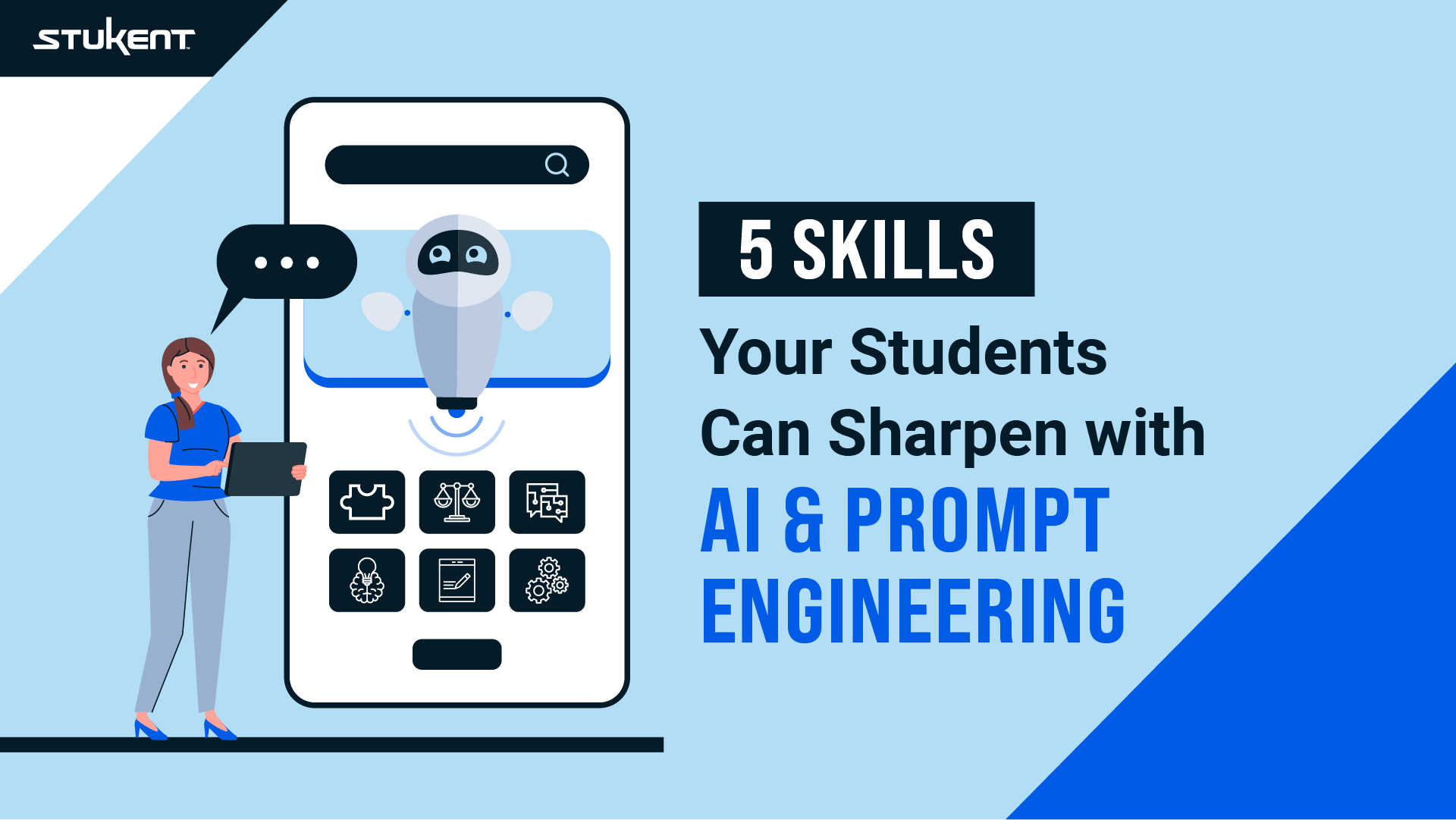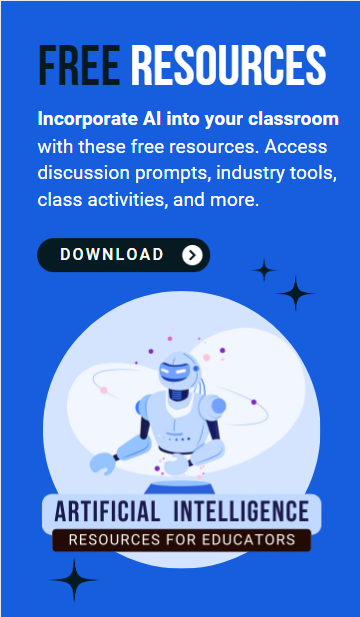Written by Christina Kalberg, an assistant professor of marketing at Point Loma Nazarene University.
Do you worry artificial intelligence (AI) tools like ChatGPT will limit the development of important skills college students need to learn such as writing, critical thinking, and creativity? Me too. Until I started allowing the use of AI and included prompt engineering exercises in the classroom. What I discovered was astounding. The same students who turned in writing assignments riddled with grammar and spelling errors in a previous course without AI were now submitting work free of errors and much more enjoyable to read.
Think of ChatGPT like a calculator. When the calculator came out many scholars believed it would prevent students from learning math. Instead, it helped students develop problem-solving skills. ChatGPT and other generative AI tools are the same — they help students produce more work that is higher quality.
If you don’t buy into the calculator analogy, remember when Google came on the scene? It had a similar impact in higher education as AI is having today. Scholars were concerned Google would change the way people think, read, and memorize. Google would make students lazy and the art of finding information would die. It didn’t. In fact, Google became a tool we all use to be more proficient in research.
New technology will always have pros and cons. After 12 months of embracing AI in the classroom, I found the pros outweigh the cons. The work submitted by students was better than I had seen in the past 10 years. Class became fun again! Instead of reviewing the basics of grammar and spelling, I had conversations with students about the context of their writing and creative brainstorming sessions. And, students developed these five essential skills more quickly:
- Communication
- Creativity
- Critical thinking
- Problem-solving
- Ethical decision-making
1. Communication
College students often struggle with a starting point for writing assignments. Writer’s block creates a hurdle to producing work in a timely manner. AI is a tool students use to overcome this hurdle. They are using AI as a brainstorming tool for communication. When students don’t know what to say or how to say it, they now have a writing assistant readily accessible. I gave my students a classroom poll, and 100% of them use AI as a brainstorming tool. Ninety-three percent use it to develop headlines and 75% to outline content. Instead of spending hours staring at a blank piece of paper, students have a tool they can use to create a first draft. With the additional time gained, more students are reading the first draft and editing it to make sure it achieves the learning objective.
2. Creativity
Will.i.am at the 2023 World Economic Forum (WEF) in Davos, Switzerland said that ChatGPT is going to become the “great co-pilot for creatives” because it raises the bar on everyone’s ability to be creative. Removing barriers to writing and nearly eliminating writer’s block altogether gives students the mental capacity to do more. Nearly all my students (93%) say that AI helps them be more creative. Amanda Rodriquez, business student at Point Loma Nazarene University (PLNU) and founder of Free Brands, says, “ChatGPT is like a calculator. I don’t always need it but when I do, it helps me do more than I could on my own.”
Before integrating AI tools in a Digital Marketing Essentials course at PLNU, students would produce a blog and email for real-world clients as part of experiential learning in a 16-week course. It was all the capacity for creativity at the time. In the same course, students are now using AI to develop 1,000-word blogs, short-form videos, content for podcast episodes, and still images to promote products on social media. And, this is accomplished in eight weeks instead of 16. Creativity flowed in the classroom thanks to generative AI tools like:
3. Critical Thinking
A calculator does not give you a right answer unless you input the correct numbers. AI tools are the same way. Students must know what prompt to give ChatGPT or Pictory or DALL-E to get an accurate output. Most students are still learning how to do prompting effectively. This is where they enhance critical thinking skills because often the output provided the first time is not sufficient, requiring students to come up with a second prompt. Sometimes it requires multiple iterations of the same prompt to finally get a useful output such as a blog headline or an image that is not distorted. Copying and pasting the information provided from an AI tool is not sufficient. Below is the AI policy adopted for use inside and outside of the classroom. It requires students to further think about how they can “own” the work and ensure that a “human touch” is added to the machine generated content for each and every assignment.
4. Problem-Solving
AI tools offer opportunities for improved creativity and innovation in business. AI is more accessible to businesses, making it easier than ever to ideate and come up with new ways to solve existing problems in the world. Douglas C. Schmidt, Jesse Spencer-Smith, Quchen Fu, and Jules White at Vanderbilt University say, “The rapid advent of Large Language Models (LLMs), such as ChatGPT and Claude, is revolutionizing various fields, from education and healthcare to the engineering of reliable software systems. […] Given the novelty of LLMs, the understanding of how to effectively use prompts remains largely anecdotal, based on isolated use cases.” Because of its novelty and ability to solve problems, prompt engineering is a highly sought-after job skill that employers are looking for in new hires. Practicing this new skill set in the classroom with guided direction from the instructor and real-time feedback increases a student’s capacity to use an AI tool for problem-solving.
5. Ethical Decision-Making
Educators who embrace the use of AI in higher education find that students see the benefits of ChatGPT along with the limitations and have a healthy dose of skepticism about how much it should be used. ChatGPT and other AI tools should be taught to supplement human communication but not replace it. The tools can and should be used to brainstorm ideas and begin a task but should not be the end-all and be-all in the process. Michael Farrington, the Chief People Officer at Globus Medical, says, “Teaching students the rules of engagement is just as important as helping students learn the skill of prompting.”
Higher education has an opportunity to be the learning ground for this new skill set. Beyond the essential skills developed using AI in the classroom, 100% of my students say that it enhanced the learning experience. The good news is nearly three-quarters say that while they enjoy using AI in the classroom, it should not be solely relied upon.
Understanding the limitations and determining when to use AI and when not to use it is equally important. Practicing ethical decision-making in the classroom will prepare your students for success.
Incorporate AI into your course with classroom activities, discussions, and the latest industry tools. Download free AI resources by going here: AI Resources for Educators
Christina Kahlberg is an assistant professor of marketing at Point Loma Nazarene University. For over 20 years, she has been helping organizations grow their business and extend their brand awareness through strategic and integrated B2B and B2C marketing, fundraising, public relations, public advocacy, public speaking, and leadership. She has raised over $40M for local nonprofits using online and offline tactics such as sales, organic and paid advertising, email marketing, social media marketing, search engine marketing, search engine optimization, designing conversion-centered websites and landing pages.
References
- Atlas, S. (2023). ChatGPT for higher education and professional development: A guide to conversational AI. College of Business Faculty Publications, The University of Rhode Island.
- Clark B. (2023). A generative AI teaching exercise for marketing classes. Medium. Retrieved from https://bruceclarkprof.medium.com/a-generative-ai-teaching-exercise-for-marketing-classes-6fb09af0a565.
- Eapen T., Finkenstadt D., Folk J., Venkataswamy L. (2023). How generative AI can augment human creativity. Harvard Business Review. Retrieved from https://hbr.org/2023/07/how-generative-ai-can-augment-human-creativity.
- Huallpa, J. J. (2023). Exploring the ethical considerations of using Chat GPT in university education. Periodicals of Engineering and Natural Sciences, 11(4), 105-115.
- Rahman, M. M., & Watanobe, Y. (2023). ChatGPT for education and research: Opportunities, threats, and strategies. Applied Sciences, 13(9), 5783.
- Schmidt, D. C., Spencer-Smith, J., Fu, Q., & White, J. (2023). Towards a catalog of prompt patterns to enhance the discipline of prompt engineering. Department of Computer Science, Vanderbilt University.
- Smith M. (2023). ChatGPT is the hottest new job skill that can help you get hired, according to HR experts. Retrieved from https://www.cnbc.com/2023/04/05/chatgpt-is-the-newest-in-demand-job-skill-that-can-help-you-get-hired.html.
- Uta J. (2023). 9 best uses for ChatGPT for marketing, sales and business. Retrieved from https://brandminds.com/9-best-uses-of-chatgpt-for-marketing-sales-and-business/.
- Vázquez-Cano, E., Ramirez-Hurtado, J. M., Saez-Lopez, J. M., & Lopez-Meneses, E. (2023). ChatGPT: The brightest student in the class. Thinking Skills and Creativity, 49, 101380.
- Wiggers K. (2023). ChatGPT prompts: How to optimize for sales, marketing, writing, and more. Retrieved from https://techcrunch.com/2023/06/28/chatgpt-prompts-how-to-optimize-for-sales-marketing-writing-and-more/.







